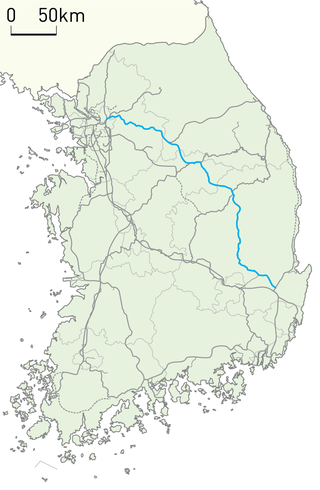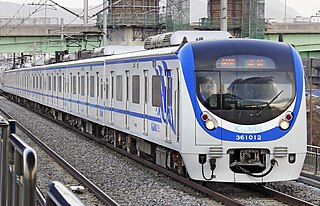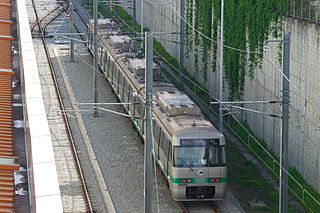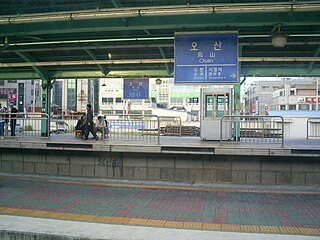
Incheon, formerly Jemulpo or Chemulp'o (제물포) until the period after 1910, officially the Incheon Metropolitan City, is a city located in northwestern South Korea, bordering Seoul and Gyeonggi to the east. Inhabited since the Neolithic, Incheon was home to just 4,700 people when it became an international port in 1883. Today, about 3 million people live in the city, making it South Korea's third-most-populous city after Seoul and Busan.

The Jungang line is a railway line connecting Cheongnyangni in Seoul to Moryang in Gyeongju in South Korea, traversing central South Korea from the northwest to the southeast. It is also referred to as the rail line of the Seoul Metropolitan Subway from Yongsan station to Jipyeong station. The section from Cheongnyangni to Dodam was designated as a semi-high-speed railway.

The Gyeongchun Line is a regional rail line between Seoul and Chuncheon, South Korea, operated by Korail. Its name is derived from Gyeong and Chuncheon. It was completely reconstructed in the 2000s. Service on it has operated between Sangbong station on the Jungang Line in eastern Seoul and Chuncheon station, as part of the Seoul Metropolitan Subway system, since December 21, 2010. A class of regional rail service named ITX-Cheongchun began operations on February 28, 2012, linking Chuncheon to Cheongnyangni and Yongsan Stations.

The Gyeongui Line is a railway line between Seoul Station and Dorasan Station in Paju. Korail operates the Seoul Metropolitan Subway service between Seoul Station and Dorasan Station.

Seoul Subway Line 8 of the Seoul Metropolitan Subway was built from 1990 to 1999 and mainly serves the southeastern parts of Seoul and Seongnam. The first section from Jamsil to Moran opened in 1996, and the second section from Moran to Amsa was opened in July 1999. The line color is rose. In 2019, Line 8 had an annual ridership of 112 million or about 307,000 people per day. At 17.7 km (11.0 mi) in length, Line 8 is the shortest of all heavy rail Seoul Metropolitan Subway lines.

Daejeon Subway Line 1 is a subway line is located in Daejeon, South Korea. After excluding the Seoul metropolitan area, it was the fourth subway line created in South Korea, following Busan, Daegu, and Gwangju. Its line color is ● green. It is 22.6 km (14.0 mi) long with 22 stations. It is the first of five planned lines for the Daejeon Metro.

Seoul Subway Line 9, operated by Seoul Line9 Operation, is a subway line in Seoul, part of the Seoul Metropolitan Subway. The line runs east from Gaehwa station or Gimpo International Airport station along the south bank of the Han River towards VHS Medical Center in Gangdong. In 2019, Line 9 had an annual ridership of 225 million or about 616,000 people per day.

Gwanghwamun Station (Korean: 광화문역) is a station on the Seoul Subway Line 5 in South Korea. It is not the closest subway station to the actual gate of Gwanghwamun, which it is named after. It is located next to the U.S. Embassy in Seoul.

Wangsimni Station is a station on Seoul Subway Line 2, Seoul Subway Line 5, Gyeongui–Jungang Line, and Suin–Bundang Line; most Suin–Bundang Line trains end service here, though a few daily services continue along the tracks used by the Gyeonggi-Jungang line to terminate at the next station, Cheongnyangni in northeastern Seoul. It is located in Haengdang-dong, Seongdong-gu, Seoul.

Dongjak District (Dongjak-gu) is one of the 25 gu that make up the city of Seoul, South Korea. Its name was derived from the Dongjaegi Naruteo Ferry, on the Han River which borders the district to the north. It was the 17th gu created in Seoul, after being separated from Gwanak District on 1 April 1980.

Danggogae Station (Korean: 당고개역) is a station on Line 4 of the Seoul Metropolitan Subway network. It was the northern terminus of Line 4, until 19 March 2022, when the line was extended to Jinjeop. It is an elevated station. The name of the subway station comes from its local name. Regional names refer to the pass that travelers carried over because of wild animals.

Gwangmyeong station (Korean: 광명역) is a train station in Gwangmyeong, South Korea. The station was newly built as a stop of national railway operator Korail's KTX high-speed service, 22.0 km (13.7 mi) south of Seoul Station.

Dobongsan Station is a subway station on the Seoul Subway Line 1 and Line 7. It is the closest station to Mt. Dobong, where its name also comes from.

Osan Station is a train station on the Gyeongbu Line, and is also served by Seoul Subway Line 1. This is the main station in the city of Osan. There are many shops and restaurants located just outside the station. There is a bus terminal located next to the station and many local buses stop in front of the station. The name of the station was named after the area's surrounding area.

Incheon Subway Line 2 is a driverless, medium-capacity subway line running 29.2 km (18.1 mi) from Oryu-dong in Seo-gu to Incheon Grand Park, with 27 stations, part of the Incheon Subway system. The line is also included as a part of the overall Seoul Metropolitan Subway network; Juan station has a free transfer with Seoul Subway Line 1, Geomam station connects with the AREX Line to Incheon International Airport and Seoul Station, and Seongnam also has a free transfer with Seoul Subway Line 7.

Bupyeongsamgeori Station is a subway station on Line 1 of the Incheon Subway located at 770 Bupyeong-dong, 766 Gyeonginno Jiha, Bupyeong-gu, Incheon, South Korea.

Campus Town Station is a subway station on Line 1 of the Incheon Subway in Jiha66, Songdogukje-daero, Yeonsu-gu, Incheon. Its other name is Yonsei University.

Central Park Station is a subway station on Line 1 of the Incheon Subway in Jiha240, Incheon-tower-daero, Yeonsu-gu, Incheon, South Korea.

Bundang (Korean: 분당) is a planned community in the Bundang-gu district of Seongnam, South Korea. It was developed to encourage affordable housing and urban decentralization. The community has a sports complex, a park and a youth center.

Station numbering is a sign system which assigns station codes consisting of a few letters and numbers to train stations. It aims to facilitate navigation for foreign travelers not familiar with the local language by using globally understood characters. The system is now in use by various railway companies around the world such as in Mainland China, Indonesia, Japan, South Korea, Singapore, Taiwan, Thailand, and the United States.





















